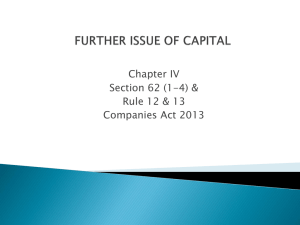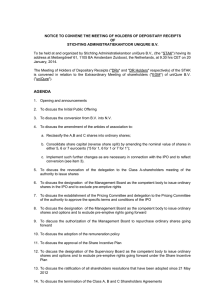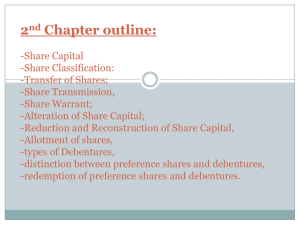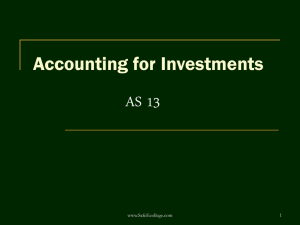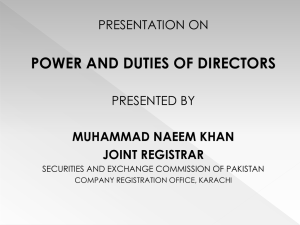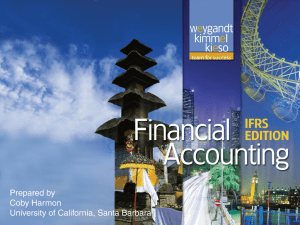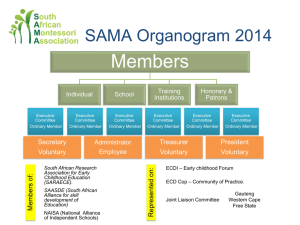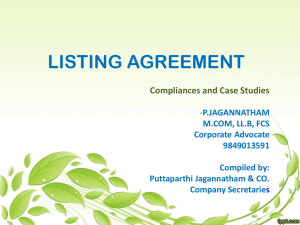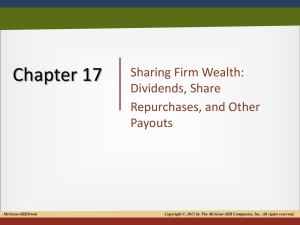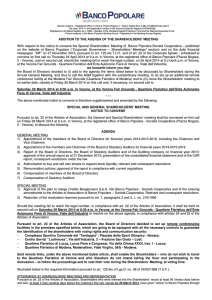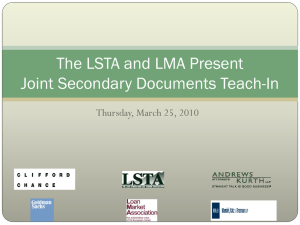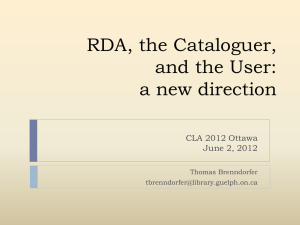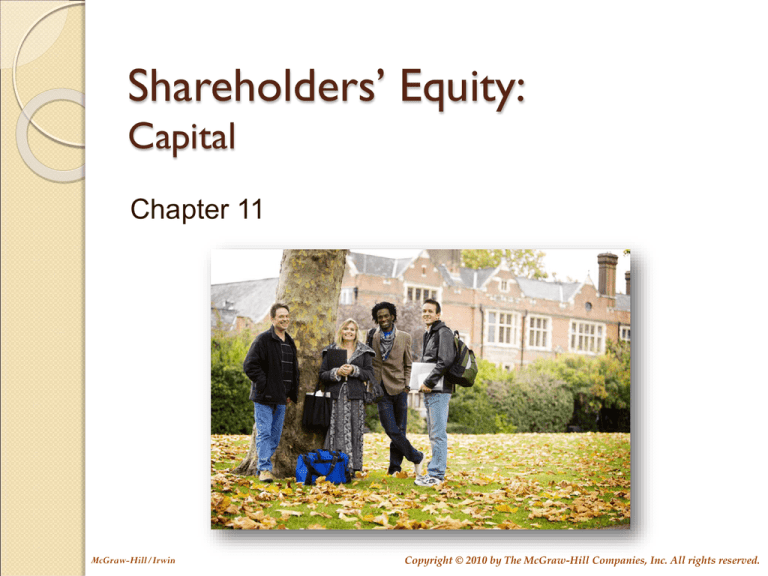
Shareholders’ Equity:
Capital
Chapter 11
McGraw-Hill/Irwin
Copyright © 2010 by The McGraw-Hill Companies, Inc. All rights reserved.
Corporations
An entity created
by law.
Existence is
separate from
owners.
Ownership
can be
Privately, or
Closely Held
Has rights and
privileges.
Publicly Held
11-2
Advantages of Incorporation
Limited personal
liability for
shareholders
Transferability of
ownership
Professional
management
Continuity of
existence
11-3
Disadvantages of Incorporation
Heavy taxation
Greater regulation
Cost of formation
Separation of
ownership and
management
11-4
Formation of a Corporation
• Each corporation is formed
according to the laws of
the place or country where
it is located.
The costs
associated with
incorporation are
usually expensed
immediately.
• The application for
corporate status is
supported by the
Memorandum and Articles
of Incorporation.
11-5
Rights of Shareholders
Voting (in person
or by proxy).
Rights
Shareholders
Proportionate
distribution of
dividends.
Proportionate
distribution of
assets in a
liquidation.
11-6
Rights of Shareholders
Corporate Organization Chart
Ultimate
control
Shareholders
Shareholders
usually meet
once a year.
Board of Directors
President
Secretary
Treasurer
Controller
Other Vice
Presidents
11-7
Functions of the Corporate
Officers
Corporate Organization Chart
Contractual and legal
representation
Custodian of
funds
Shareholders
Board of Directors
Chief
Accountant
President
Secretary
Treasurer
Controller
Other Vice
Presidents
11-8
Publicly Owned Corporations Face
Different Rules
By law, publicly owned corporations must:
Prepare financial statements in accordance with
relevant accounting standards, e.g. IFRS.
Have their financial statement audited by an
independent CPA.
Comply with relevant rules and regulations.
Submit financial information for relevant authority
for review.
11-9
Shareholder Records in a
Corporation
Shareholder ledgers are often maintained by a
share transfer agent or share registrar.
Shareholders usually meet once a year.
Each unit of ownership is called a share.
Share certificates serve as proof that a
shareholder has purchased shares.
When the share is sold, the shareholder signs a
transfer endorsement on the back of the share
certificate.
11-10
Shareholders’ Equity of a
Corporation
Shareholders' equity is
increased in two ways.
Contributions by
investors in exchange
for share.
Retention of profits
earned by the
corporation.
Paid Capital
Retained Earnings
11-11
Authorization and Issuance
of Share Capital
Authorized
Shares
The maximum
number of
shares that can
be sold to the
public.
11-12
Authorization and Issuance
of Share Capital
Authorized
Shares
Usually
shares are
sold
through an
underwriter.
Issued
shares are
authorized
shares that
have been
sold.
Unissued
shares are
authorized
shares that
never have
been sold.
11-13
Authorization and Issuance
of Share Capital
Outstanding shares are
issued shares that are
owned by
shareholders.
Authorized
Shares
Issued
Shares
Outstanding
Shares
Treasury
Shares
Unissued
Shares
Treasury shares are
issued shares that
have been reacquired
by the corporation.
11-14
Shareholders’ Equity
• Par value is an arbitrary amount assigned
to each share when it is authorized.
• Market price is the amount that each
share will sell for in the market.
11-15
Shareholders’ Equity
Ordinary share can be issued in three forms:
Par Value
Ordinary
Share
No-Par
Ordinary
Share
Stated Value
Ordinary
Share
Let’s examine this
form of share.
All proceeds
credited to
Ordinary Share
Capital
Treated like par
value ordinary
share
11-16
Issuance of Par Value Share
Record:
1. The cash received.
2. The number of shares issued × the par value
per share in the Ordinary Share account.
3. The remainder is assigned to Share Premium
(or Additional Paid-in Capital).
Assume a corporation issues 10,000 shares
of its $2 par value share for $25 per share.
11-17
Issuance of Par Value Share
Assume a corporation issues 10,000 shares
of its $2 par value share for $25 per share.
Description
Cash
Ordinary Share
Share Premium
Debit
Credit
250,000
20,000
230,000
10,000 × $2 = $20,000
11-18
Issuance of Par Value Share
Shareholders' Equity with Ordinary Share
Shareholders' Equity
Contributed capital:
Ordinary share - $2 par value; 50,000 shares
authorized; 10,000 shares issued and
outstanding
Share premium
Retained earnings
Total shareholders' equity
$
20,000
230,000
65,000
$ 315,000
11-19
Preference Share
A separate class of share, typically having
priority over ordinary shares in . . .
Dividend distributions (rate is usually stated).
Distribution of assets in case of liquidation.
Specific characteristics (say redeemable) can
affect its presentation in the balance sheet as
liabilities (IAS 32).
Other Features Include:
Cumulative
dividend
rights.
Usually
callable by
the company.
Normally has
no voting
rights.
11-20
Cumulative Preference Share
Cumulative
Dividends in
arrears must be
paid before
dividends may be
paid on ordinary
share.
Vs.
Noncumulative
Undeclared
dividends from
current and prior
years do not have
to be paid in future
years.
11-21
Share Preferred as to Dividends
Example: Consider the following partial
Statement of Shareholders’ Equity.
Ordinary shares, $50 par value; 4,000 shares
authorized, issued and outstanding
Preference shares, 9%, $100 par value; 1,000
shares authorized, issued and outstanding
Total contributed capital
$ 200,000
100,000
$ 300,000
During 2008, the directors declare cash
dividends of $5,000. In 2009, the directors
declare cash dividends of $42,000.
11-22
Share Preferred as to Dividends
Preferred
If Preference
Share
Noncumulative:
Preferred Stock
is is
Noncumulative:
Year 2008 $5,000 dividends declared
$
Year 2009
Step 1: Current preference
dividend
$
preferred dividend
Step 2: Remainder to ordinary
commonshareholders
shareholders
If Preference
Share
Cumulative:
Preferred Stock
is is
Cumulative:
Year 2008 $5,000 dividends declared
$
Year 2009
Step 1: Dividends in arrears
$
Step 2: Current preference
dividend
preferred dividend
Step 3: Remainder to ordinary
commonshareholders
shareholders
Totals
$
5,000
Common
$
-
$
33,000
$
-
$
$
29,000
29,000
9,000
5,000
4,000
9,000
13,000
11-23
Other Features of Preference
Share
I just converted 100 shares
of preference share into
1,000 ordinary shares and
ended up with a higher
dividend yield!
Gee, I can’t do
that with MY
preference share!
Some preference
share is
convertible into
ordinary shares.
11-24
Preference Share
Shareholders' Equity with Ordinary and Preference Share
Shareholders' Equity
Contributed Capital:
Preference Share - $100 par value; 1,000 shares
authorized; 50 shares issued and
outstanding
$
5,000
Ordinary Shares - $10 par value; 50,000 shares
authorized; 30,000 shares issued and
outstanding
300,000
Share Premium
1,000
Retained Earnings
65,000
Total Shareholders' Equity
$
371,000
11-25
Market Value
Accounting by
the issuer.
Ordinary share is
carried at original issue
price.
Accounting by
the investor.
Investments in
marketable securities
are carried at market
value.
11-26
Market Price of Preference Share
Factors affecting market price of preference share:
• Dividend rate
• Risk
• Level of interest rates
The return based on the
market value is called the
“dividend yield.”
11-27
Market Price of Ordinary Share
Factors affecting
market price of
ordinary share:
Investors’
expectations of
future profitability.
Changes in
market value
have no impact
on the books
of the issuer.
Risk
that this level
of profitability will
not be achieved.
11-28
Book Value per Share
of Ordinary Share
Preference share and preference
dividends in arrears are deducted
from total shareholders’ equity.
Total Shareholders’ Equity
Number of Ordinary Shares Outstanding
Book Value ≠ Market Value
11-29
Share Splits
Companies use
share splits to
reduce market
price.
Outstanding
shares increase,
but par value is
decreased
proportionately.
Ice Cream Parlor
Share Splits
Now
Available
11-30
Share Split
Assume a corporation has 5,000 shares
of $1 par value ordinary share
outstanding before a 2–for–1 share split.
Ordinary Shares
Before Split
5,000
After Split
10,000 Increase
Par Value per Share
$
1.00
$
Total Par Value
$
5,000
$
0.50 Decrease
No
5,000 Change
11-31
Treasury Share
Treasury
shares are
issued
shares that
have been
reacquired
by the
corporation.
When share is reacquired, the corporation
records the treasury share at cost.
11-32
Recording Purchases of
Treasury Share
Riley Corporation reacquires 3,000 shares
of its ordinary share at $55 per share.
Prepare the journal entry to record the
purchase of treasury share.
Description
Description
Treasury Share
Stock
Cash
Debit
Debit
Credit
Credit
165,000
165,000
3,000 shares × $55 = $165,000
11-33
Recording Purchases of
Treasury Share
Riley Corporation reissued 1,000 shares of
the treasury share originally purchased for
$55 per share. The shares were reissued at
$75 per share.
1,000 shares × $75 = $75,000
Description
Cash
Treasury Share
Share Premium: Treasury Share
Debit
Credit
75,000
55,000
20,000
1,000 shares × $55 cost = $55,000
11-34
Shareholders’ Equity Presentation
Shareholders' Equity
Contributed capital:
Preference Share - $100 par value; 1,000 shares
authorized; 50 shares issued & outstanding
Ordinary Share - $10 par value; 50,000 shares
authorized; 30,000 shares issued and
outstanding
Share Premium
Retained earnings
Subtotal
Less: Treasury share
Total Shareholders' equity
$
$
$
5,000
300,000
21,000
65,000
391,000
110,000
281,000
11-35
Share Buyback Programs
Some corporations have buyback programs, in which
they repurchase large amounts of their own ordinary
share. As a result of these programs, treasury share
has become a material item in the balance sheet of
many corporations.
Share option plans are an important part of employee
compensation for many companies. Treasury share
purchases are an effective means by which the
company can have available the shares needed to
satisfy the requirement of share option plans to issue
the shares to employees.
11-36
Financial Analysis and
Decision Making
Return on
Total Assets =
Return on Ordinary
Shareholders’ Equity =
Profit
Average Total Assets
Profit – Preference Dividends
Average Ordinary Shareholders’ Equity
11-37
End of Chapter 11
11-38


